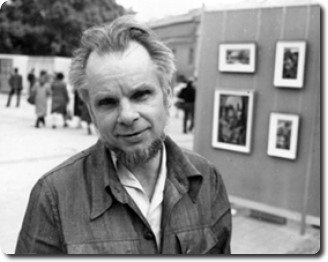The collection first took shape in 1970 at the initiative of Vincas Kisarauskas. After that, he periodically gave documents to the archive. After his death in 1988, his wife and son gave documents to the archive at various times.
Vincas Kisarauskas is well known not only as a painter, but also as a monumental artist, graphic artist, set designer and art critic. His first exhibition was closed by the government, and in 1961 his illustrations to the book Poklius tykoja kas dieną were accused of Formalism in the main newspaper of Soviet Lithuania Tiesa (Pravda). In 1963, the KGB opened a file on him, noting that 'the creative work of Vincas Kisarauskas negatively affects young people, especially students at the Art Institute.' There were attempts by government institutions and the censors to marginalise the artist. Until the collapse of the Soviet Union, the works of Kisarauskas were only accessible to small, informal groups of artists, writers and art patrons in Lithuania. In the West, however, his art gained an increasingly stronger reputation, mainly through avenues such as international exhibitions and congresses of ex-libris bookplates, and through his paintings and set designs.
He is well known in the Lithuanian school of ex-libris. There was less control and more room for improvisation in the world of ex-libris than in paintings, and Kisarauskas used ex-libris as a way to avoid strict surveillance. Ex-Libris woodcuts, engravings and etchings began as far back as the mid-15th century. Their function was initially quite practical, to signify the ownership of books. As private libraries and their owners gained wealth and prestige, however, so did their ex-libris bookplates. Before long, famous artists were commissioned by wealthy collectors to create ex-libris designs, and over the centuries, great talents such as Dürer, Holbein, Manet, Toulouse-Lautrec and Rockwell Kent all contributed significantly to this great genre. In Soviet Lithuania, Vincas Kisarauskas renewed this form of art, and used it as a niche in order to work within legitimate boundaries. In 1965, he started corresponding with the Polish artist Wojciech Jakubowski, who invited him to participate in an exhibition of contemporary ex-libris in Malbork, after which he increasingly often expressed himself in ex-libris bookplates. It was one of the possibilities for Soviet artists to participate in global art processes.
Today, Kisarauskas is perceived in art history as a prominent figure in non-conformist art, taking a personal position during the Soviet period.
Vincas Kisarauskas or his relatives have given documents to the Lithuanian Archive of Literature and Art at various stages:
1) the first gift of documents was on 3 March 1970; 14 May 1970; 15 October 1970; 7 December 1970; 10 January 1972; 8 August 1972; 5 February 1973; 15 March 1973;
2) the second was on 1 January 1974; 3 October 1975; 17 February 1977;
3) the third was on 26 March 1981;
4) the fourth was on 23 March 1984;
5) the fifth was after his death, when his wife and son gave documents to the archive on 28 April 1994 and 20 October 1994;
6) the sixth gift of Kisarauskas’ documents was on 1 January 2000; 11 February 2002; and 7 February 2003, when his wife Saulė signed agreements with the archive;
7) the new documents are under preparation for public view.

